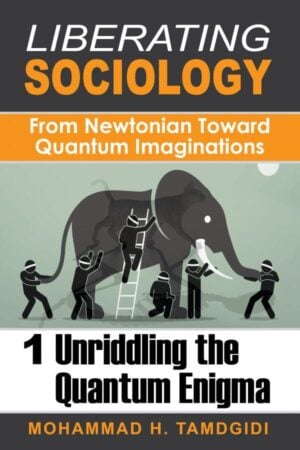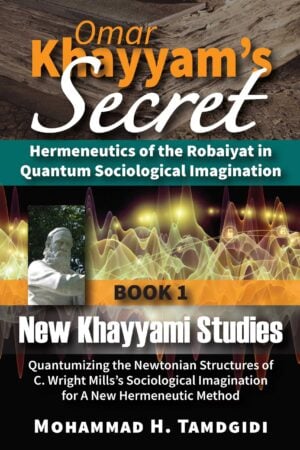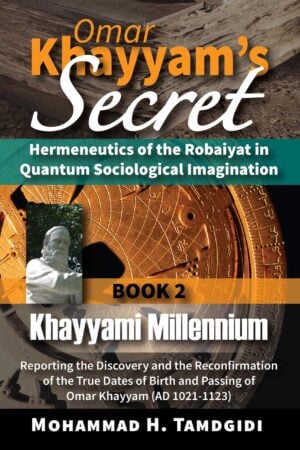Book Section: CHAPTER IV — Understanding the Succession Order and Its Active Intellect: Comparative Notes on Omar Khayyam’s Treatise on the Science of the Universals of Existence — by Mohammad H. Tamdgidi
$20.00
This essay, titled “Understanding the Succession Order and the Significance of the Active Intellect: Comparative Notes on Omar Khayyam’s Treatise on the Science of the Universals of Existence” is the fourth chapter of the book Khayyami Philosophy: The Ontological Structures of the Robaiyat in Omar Khayyam’s Last Written Keepsake Treatise on the Science of the Universals of Existence, which is the fourth volume of the twelve-book series Omar Khayyam’s Secret: Hermeneutics of the Robaiyat in Quantum Sociological Imagination, authored by Mohammad H. Tamdgidi.
Description
Abstract
This essay, titled “Understanding the Succession Order and the Significance of the Active Intellect: Comparative Notes on Omar Khayyam’s Treatise on the Science of the Universals of Existence” is the fourth chapter of the book Khayyami Philosophy: The Ontological Structures of the Robaiyat in Omar Khayyam’s Last Written Keepsake Treatise on the Science of the Universals of Existence, which is the fourth volume of the twelve-book series Omar Khayyam’s Secret: Hermeneutics of the Robaiyat in Quantum Sociological Imagination, authored by Mohammad H. Tamdgidi.
In this chapter, Tamdgidi begins drawing on his claused-based interpretive findings as reported in the previous two chapters in order to shed further light on the substantive and later (in the following two chapters) on the intellectual and historical contexts, of Khayyam’s work and how his thinking met or departed from such context. In order to offer a framework in consideration of how other scholars have explored this treatise in the intellectual context in which it was written, he offers his comments by relating to the contributions of the Iranian scholar Behnaz Hashemipour in her study of this treatise by Khayyam.
As the first topic explored, Tamdgidi writes that the notion of “succession order” (“selselat ol-tartib”) in Khayyam’s treatise is different from what has been translated in Persian as “selseleh marateb,” implying a status hierarchy. The former is a much wider and more inclusive concept than that of a hierarchical status order which imaginally assumes what is higher is necessarily nobler in status. In the descending order what is before and higher happens without the participation of human agency. In the ascending order, however, if human conscious and intentional agency is present, the nobility status can be reversed in terms of its vertical structure, even though in terms of sequence, it still follows a succession order. The difference may seem trivial, but in Tamdgidi’s view it is not so, when considering the way Khayyam’s notion of what today we refer to as structure-agency dialectic unfolds in his proposed scheme. The wider conception allows for the humankind’s causal agency to be recognized while its intellectual self-reflective capacities are actively present.
The second topic discussed is regarding the question of where the active intellect is placed in the ten-fold scheme of existence. In Tamdgidi’s view, Khayyam’s solution to the problem involved the recognition that the active intellect is to be associated with all ten-fold intellects, starting from the first but continuing down to the tenth fold (and on to humankind). In other words, Khayyam’s solution involved the realization that since intellect (and selves) as spiritual substances are indivisible, it makes no sense to associate a “level” or “onion ring” metaphor to the intellects as if only the first, or the last, or any in between, is solely identifiable with the active intellect. The ten-fold intellects are not divisible or separable from one another, but are all expressions of the same one intellect in its journey to knowing itself in search of its Beloved Source, God. Khayyam’s solution is “neither this, nor that,” but synthesizes the positions of Avicenna, Farabi, and al-Ikhwan, transcending even those of Plotinus and Ptolemy who, following the Aristotelian logic, had assumed that, applying a formal dualistic logic, one can separate the intellects from one another as “levels” resulting in the necessity of associating the numbers to the intellects as separate, divisible, entities.
A third topic is regarding the way the love motivation engages the soul/self not only in the triad of intellect/self/body, but also vertically in holding the overall architecture of the succession order together. Tamdgidi tries to illustrate the difference it can make to view Khayyam’s ten-fold triadic structure of the universal substance in a holistic way, rather than as fragmented into separate things and levels. For Khayyam, the universe is a singular reality characterized by inseparability, at once spiritual and bodily. It spirals from and toward its Beloved Source, and its whole and parts can be best understood in a holistic way, and not in a top-to-bottom, fatalistic and predeterministic way, but as dependent also on the extent to which spiritual self-knowledge is achieved by its parts regarding their place in the whole, realizing the vision of a participatory universe. In such a worldview, the universal active intellect as much needs humankind as humankind needs the active universal intellect in seeking knowledge about their common Beloved Source.
But the key point here, epistemologically, is this. The awakening is not, and cannot be, merely an intellective effort, since humankind is a compound of body and emotionally self-reflective intellect. It has to face the challenges of balancing the fettering distractions of the body, the emotions, and the intellective pursuit of knowledge. A methodology of relying only on one or another of the three sides will not work, for the method itself has to be holistic in nature, facing the challenges of habits of the body, of the feelings, and of the mind. And it has only a brief lifetime to face the challenges, and the rewards are not necessarily offered in an afterlife, so, better is that they are found amid the cash of the present here-and-now, while the body is still alive, its cup still not broken.
Moving to a fourth topic, in Tamdgidi’s view, for Khayyam intellect and self cannot carry out their activities without one another, and each is dependent on the other. This implies that for Khayyam intellect, to know the intelligibles, must necessarily be self-reflective and thus needing the self as well. Without such an assumption, we would run into difficulty having a notion of succession order. Without such an assumption of interdependence and “needing” of one another, we may end up assuming that intellect does not need a self, and, by extension, not a sphere and its associated mass and body to pursue the goal of seeking its Beloved Source. Human relinking with the universal active intellect for reawakening is not a linking to an outside, but to an inner voice that is there, but is not being heard.
Moving on to a fifth topic, Tamdgidi suggests that Khayyam’s perspective is not just any form of conceptualism, but a specific form of it, what can be called “quantum conceptualism.” In today’s language, we may call Khayyam’s approach quantum conceptualism because he does not deny objective reality, but considers the subject itself as a part of that objective reality and thus empowered to have real and substantive impact on how the universal reality is and can be constituted. For him, the universe is not just a given, but also what we make of it, depending on whether in our brief lifetime we become self-reflectively conscious of our place in the succession order and act accordingly to advance the duties such a realization implies. In the author’s view, Khayyam’s perspective seems to display, intuitively, all the eight attributes of being quantum in orientation, as described previously in Tamdgidi’s study in the sociology of scientific knowledge of the quantum enigma (2020).
As for the sixth topic, Tamdgidi discusses how Khayyam’s view as expressed in the last section of the treatise on four paths, according to which there is nothing veiled from the seeker, and that it is the impurities of self and distractions of body that stands in the way of humankind’s experiencing the Presence of God as the ultimate paradise in this-worldly lifetime. By clearing the impurities, we make it possible to know what we, as emanations of the active intellect as a microcosm, already have within us, rather than having to await the intervention of a separate master, teacher, guru, or middle-man, from without to provide us spiritual fulfillment. The point is not to deny the need for receiving wisdom from others and teachers; the point is that even seeking and seeing the light from them requires what Khayyam calls efforts at self-purification. The same teacher or guru can impart knowledge but how it is received would differ in extent and depth depending on how the recipient has progressed based on its own efforts on the meditative path of self-purification.
So, Sufi teaching also cannot and should not be, as what today Paulo Freire would call, a “banking” process. It is always dialogical, and a blind following of a guru would simply not work. Khayyam’s path to seeking the knowledge of God would not be a traditional path of blind, hierarchical, following, but one characterized by a free-thinking spirit seeking after existential truths, fully engaged in meditative self-purification of the intellective, emotional, and physical habits of the body so as to self-reflectively know and experience existential truth.
For a seventh topic, Tamdgidi discussed how paramount in Khayyam’s worldview it is to explain and illustrate the One and the many as two-sides of the same reality of existence. So, in his view, numbers function less as a means of showing the separateness and multiplicity of things, and more as portraying the different manifestations of the same one substance from which the created universe all began. What Hashemipour’s drawing on Plotinus has insightfully revealed is the important point one can also read in Khayyam regarding seeing the intellect/self/sphere triad holistically. Instead of seeing the three as separate things, we need to see them as the movement of intellect, or consciousness, becoming self-reflective, and thereby setting in motion the sphere. It is the intellect that becomes self-reflective and sets itself in motion through the ten-fold spheres in search of its Beloved Source; it is one thing that ‘splits’ and rejoins, undergoing a dialectical process.
Recommended Citation
Tamdgidi, Mohammad H. 2021. “CHAPTER IV — Understanding the Succession Order and Its Active Intellect: Comparative Notes on Omar Khayyam’s Treatise on the Science of the Universals of Existence.” Pp. 179-206 in Omar Khayyam’s Secret: Hermeneutics of the Robaiyat in Quantum Sociological Imagination: Book 4: Khayyami Philosophy: The Ontological Structures of the Robaiyat in Omar Khayyam’s Last Written Keepsake Treatise on the Science of the Universals of Existence. (Human Architecture: Journal of the Sociology of Self-Knowledge: Vol. XVII, 2021. Tayyebeh Series in East-West Research and Translation.) Belmont, MA: Okcir Press.
Where to Purchase Complete Book: The various editions of the volume of which this Book Section is a part can be ordered from the Okcir Store and all major online bookstores worldwide (such as Amazon, Barnes&Noble, Google Play, and others).
Read the Above Publication Online
To read the above publication online, you need to be logged in as an OKCIR Library member with a valid access. In that case just click on the large PDF icon below to access the publication. Make sure you refresh your browser page after logging in.







